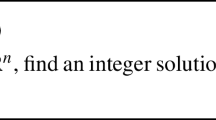Abstract
Intersection computation of convex sets is a typical problem in distributed optimization. In this paper, the algorithm implementation is investigated for distributed convex intersection computation problems. In a multi-agent network, each agent is associated with a convex set. The objective is for all the agents to achieve an agreement within the intersection of the associated convex sets. A distributed “projected consensus algorithm” is employed, and the computation of the projection term is converted to a constrained optimization problem. The solution of the optimization problem is determined by Karush-Kuhn-Tucker (KKT) conditions. Some implementable algorithms based on the simplex method are introduced to solve the optimization problem. Two numerical examples are given to illustrate the effectiveness of the algorithms.
Similar content being viewed by others
References
Boyd S and Vandenberghe L, Convex Optimization, Cambridge University Press, New York, 2004.
Nocedal J and Wright S J, Numerical Optimization, Second Edition, Springer-Verlag, New York, 1999.
Boyd S, Parikh N, Chu E, et al., Distributed optimization and statistical learning via the alternating direction method of multipliers, Foundations and Trends in Machine Learning, 2011, 3(1): 1–122.
Liu Z, Yuan Y, Guan X, et al., An approach of distributed joint optimization for cluster-based wireless sensor networks, IEEE/CAA J. Automatica Sinica, 2015, 2(3): 267–273.
Barrias A, Casas J R, and Villalba S, A review of distributed optical fiber sensors for civil engineering applications, Sensors, 2016, 16(5): 748–782.
Hong Y and Zhai C, Dynamic coordination and distributed control design of multi-agent systems, Control Theory and Applications, 2011, 28(10): 1506–1512.
Wen G, Zhao Y, Duan Z, et al., Containment of higher-order multi-leader multi-agent systems: A dynamic output approach, IEEE Trans. Autom. Control, 2016, 61(4): 1135–1140.
Qiu Z, Liu S, and Xie L, Distributed constrained optimal consensus of multi-agent systems, Automatica, 2016, 68: 209–215.
Ma C, Li T, and Zhang J, Consensus control for leader-following multi-agent systems with measurement noises, Journal of Systems Science and Complexity, 2010, 23(1): 35–49.
Ma C and Zhang J, On formability of linear continuous-time multi-agent systems, Journal of Systems Science and Complexity, 2012, 25(1): 13–29.
Wang B and Zhang J, Consensus conditions for multi-agent systems with unbalanced topology and stochastic disturbances, J. Syst. Sci. and Math. Sci., 2009, 29(10): 1353–1365 (in Chinese).
Mohammadi J, Hug G, and Kar S, Agent-based distributed security constrained optimal power flow, IEEE Trans. Smart Grid, 2018, 9(2): 1118–1130.
Braun P, Grüne L, Kellett C M, et al., A distributed optimization algorithm for the predictive control of smart grids, IEEE Trans. Autom. Control, 2016, 61(12): 3898–3911.
Wang Y, Mao S, and Nelms R M, Distributed online algorithm for optimal real-time energy distribution in the smart grid, IEEE Internet of Things Journal, 2014, 1(1): 70–80.
Guo P, Cao J, and Zhang K, Distributed topological convex hull estimation of event region in wireless sensor networks without location information, IEEE Trans. Parallel and Distributed Systems, 2015, 26(1): 85–94.
Hajihoseini A and Ghorashi S A, Distributed spectrum sensing for cognitive radio sensor networks using diffusion adaptation, IEEE Sensors Letters, 2017, 1(5): 1–4.
Jiang Y and Jiang J C, Understanding social networks from a multiagent perspective, IEEE Trans. Parallel and Distributed Systems, 2014, 25(10): 2743–2759.
Ilyas M U, Shafiq M Z, Liu A X, et al., A distributed algorithm for identifying information hubs in social networks, IEEE J. Selected Areas in Communications, 2013, 31(9): 629–640.
Giordano A, Spezzano G, Vinci A, et al., A cyber-physical system for distributed real-time control of urban drainage networks in smart cities, Internet and Distributed Computing Systems, LNCS 2014, 8729: 87–98.
Nedić A and Ozdaglar A, Distributed sub-gradient methods for multi-agent optimization, IEEE Trans. Autom. Control, 2009, 54(1): 48–61.
Hong Y and Zhang Y, Distributed optimization: Algorithm design and convergence analysis, Control Theory and Applications, 2014, 31(7): 850–857 (in Chinese).
Shi G, Johansson K, and Hong Y, Reaching an optimal consensus: Dynamical systems that compute intersections of convex sets, IEEE Trans. Autom. Control, 2013, 58(3): 610–622.
Aronszajn N, Theory of reproducing kernels, Trans. Amer. Math. Soc., 1950, 68(3): 337–404.
Gubin L G, Polyak B T, and Raik E V, The method of projections for finding the common point of convex sets, U.S.S.R Comput. Math. Math. Phys., 1967, 7(6): 1–24.
Nedić A, Ozdaglar A, and Parrilo P A, Constrained consensus and optimization in multi-agent networks, IEEE Trans. Autom. Control, 2010, 55(4): 922–938.
Rockafellar R T, Convex Analysis, Princeton Univ. Press, Princeton, NJ, 1972.
Godsil C and Royle G, Algebraic Graph Theory, Springer-Verlag, New York, 2001.
Aubin J and Cellina A, Differential Inclusions, Springer-Verlag, Berlin, 1984.
Murty K G, Linear Complementarity, Linear and Nonlinear Programming, Helderman-Verlag, Berlin, 1988.
Author information
Authors and Affiliations
Corresponding author
Additional information
This work was supported by the National Natural Science Foundation of China under Grant Nos. 61773241 and 61503218.
This paper was recommended for publication by Editor HONG Yiguang.
Rights and permissions
About this article
Cite this article
Wang, B., Yu, X. & Pang, D. Algorithm Implementation for Distributed Convex Intersection Computation. J Syst Sci Complex 33, 15–25 (2020). https://doi.org/10.1007/s11424-019-8161-9
Received:
Revised:
Published:
Issue Date:
DOI: https://doi.org/10.1007/s11424-019-8161-9




